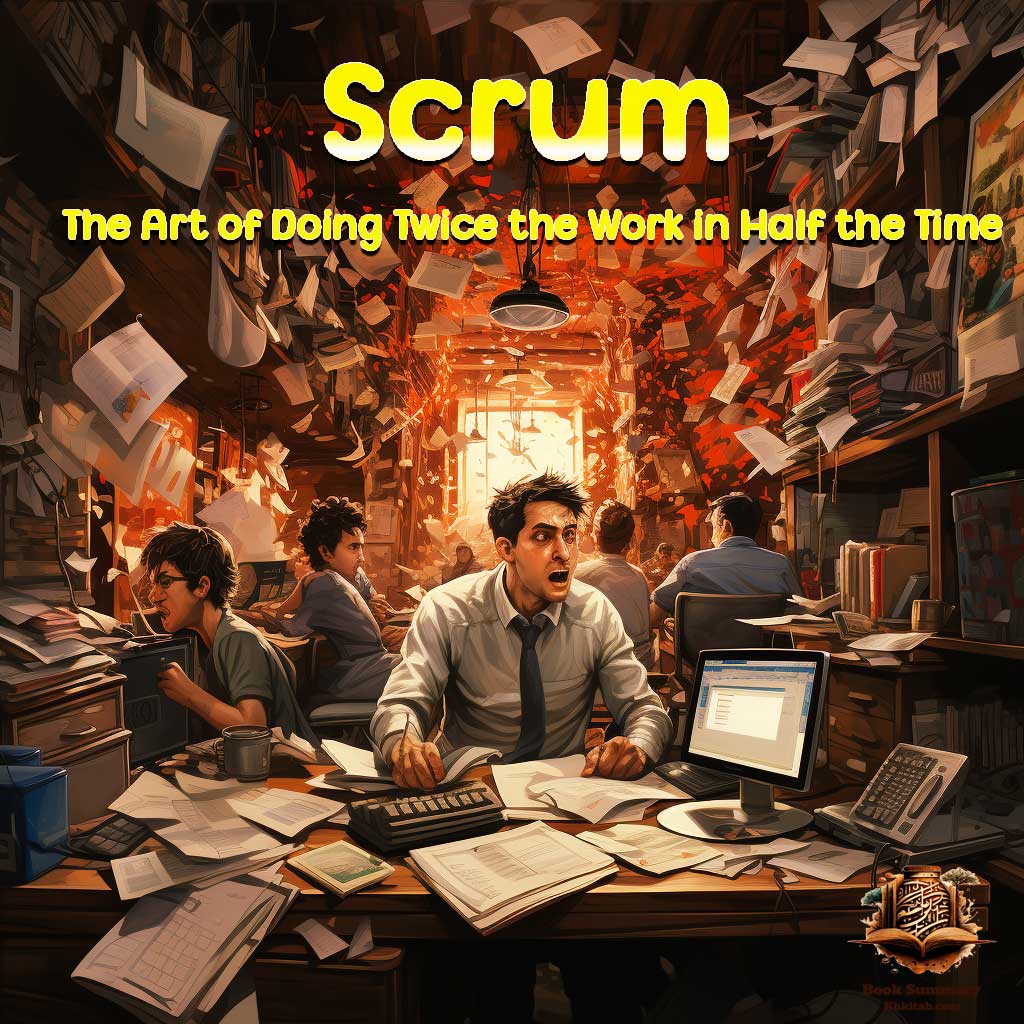Scrum: The Art of Doing Twice the Work in Half the Time

In today’s fast-paced world, there’s a relentless quest for individuals and organizations to maximize productivity and efficiency. Enter “Scrum: The Art of Doing Twice the Work in Half the Time.” In this seminal work, author Jeff Sutherland introduces a revolutionary project management system centered around collaborative team dynamics and rapid adaptation to change.
While the book’s genesis revolves around software development—where Scrum methodologies were initially employed—it’s worth noting that Sutherland’s teachings transcend this sphere. Scrum’s principles have been embraced across diverse industries, transforming the way organizations turn ideas into tangible products or services, delivering them with unprecedented speed and efficiency.
“Scrum: The Art of Doing Twice the Work in Half the Time” stands as a practical guide, offering strategies and tools to navigate common challenges that teams face. Through a tapestry of real-world examples and narratives, Sutherland illustrates how Scrum has enabled organizations to attain remarkable successes.
In conclusion, this book is a quintessential reference for anyone looking to amplify their productivity, be it within a team setting or individually. It equips readers with the necessary tools to thrive in the contemporary business landscape.
إقرأ أيضا:الذكاء العاطفي: مفتاح التوازن والنجاح في الحياةWhat is Scrum and How Did It Revolutionize Software Development?
In the ever-evolving world of project management and product development, “Scrum: The Art of Doing Twice the Work in Half the Time” stands out as a beacon for teams striving for efficiency and excellence. The core concept introduced is Scrum, a transformative approach to handling projects, particularly in the realm of software development.
Scrum is not just a methodology; it’s a mindset shift. Born in the crucible of software development challenges, where project requirements often change faster than developers can adapt, Scrum offers a solution to the unpredictability of this field. It breaks down the monumental task of product creation into smaller, manageable chunks known as ‘sprints.’ These sprints, generally lasting two weeks, enable teams to prioritize tasks, adapt to new information, and deliver tangible results in shorter timeframes.
The origins of Scrum can be traced back to a desire to escape the rigid confines of traditional project management. Traditional methods, often bogged down by extensive documentation and fixed plans, were found lacking in the dynamic world of software creation. Scrum, with its flexibility and emphasis on collaboration, emerged as the antidote. It fosters an environment where teams are empowered to make decisions, stakeholders are engaged throughout the process, and products evolve based on real-time feedback and iterative development.
Jeff Sutherland, in “Scrum: The Art of Doing Twice the Work in Half the Time,” doesn’t just detail the mechanics of Scrum; he delves into its very essence. He paints a vivid picture of a world where teams are more responsive, products are more aligned with user needs, and projects come to life in half the usual time.
In essence, Scrum is more than just a system; it’s a revolution in thinking. It challenges us to rethink how we approach work, collaborate with others, and deliver value consistently. As you navigate the pages of Sutherland’s book, you’ll discover a roadmap to a more agile, efficient, and effective future in software development and beyond.
Our Facebook Page – Book Summary
How Does the Scrum Framework Transform Traditional Workflows?
In the dynamic landscape of project management, the Scrum framework, as highlighted in “Scrum: The Art of Doing Twice the Work in Half the Time,” has carved a niche for itself, becoming an integral part of countless successful projects worldwide. But what exactly is this framework, and how does it redefine the conventions of work management?
The heart of the Scrum framework lies in its well-defined, yet flexible components. Sprints, typically two-week cycles, stand at the forefront of this methodology. Instead of embarking on a long, often daunting journey to complete a project, teams break down their tasks into smaller, manageable parts. Each sprint focuses on a select group of tasks, ensuring that there’s a tangible output at regular intervals, fostering both momentum and motivation.
Then, there’s the product backlog. Think of it as a dynamic to-do list, encompassing every feature, function, and enhancement envisioned for the final product. The product backlog is not static; it evolves. As market conditions shift, user needs change, or new insights emerge, the backlog adjusts, ensuring that the project remains aligned with its objectives and relevant to its audience.
Lastly, sprint reviews add another layer of dynamism. At the end of each sprint, the team convenes to assess the work done. It’s an opportunity for introspection, learning, and recalibration. By discussing what went well, what could be improved, and how to adapt for future sprints, teams ensure they are on the right track and continuously refining their approach.
In essence, the Scrum framework, as portrayed in “Scrum: The Art of Doing Twice the Work in Half the Time,” moves away from the linear, set-in-stone methodologies of the past. It embraces change, champions flexibility, and promotes a culture of continuous learning and adaptation. For any organization or individual yearning for efficiency combined with adaptability, understanding the core components of Scrum is the first step towards transformative success.
Business & Finance Management – Book Summary (khkitab.com)
Who Are the Key Players in a Scrum Team and What Do They Do? from Scrum: The Art of Doing Twice the Work in Half the Time
Scrum, as illuminated in “Scrum: The Art of Doing Twice the Work in Half the Time,” is not just a methodology; it’s a collaborative ecosystem where every team member has a specific and pivotal role to play. But who are these key players in a Scrum team, and what responsibilities do they shoulder?
- Product Owner: Often dubbed the ‘visionary,’ the Product Owner is the voice of the end-user or client within the team. Their primary responsibility is to define the product’s vision and break it down into actionable tasks. These tasks form the product backlog, a prioritized list of features, enhancements, and bug fixes that the product needs. The Product Owner’s role is essential in ensuring that the team always works on the most value-adding tasks and keeps the end-users’ needs at the forefront.
- Scrum Master: Think of the Scrum Master as the team’s coach. They don’t manage; they facilitate. Their mission is to ensure that the Scrum process runs smoothly by helping the team adhere to Scrum practices and principles. They’re also the shield, protecting the team from external interruptions and distractions. The Scrum Master works closely with the Product Owner to plan sprints and reviews, ensuring that goals are clear and the team is set up for success.
- Development Team: This is the heart of the Scrum machinery. The Development Team consists of professionals who do the actual work of delivering the product increment. They’re cross-functional, meaning they have all the skills necessary to produce a working product increment. Unlike traditional models where tasks are assigned, in Scrum, the Development Team chooses tasks from the product backlog, fostering ownership and commitment. They collaborate, brainstorm, and solve problems together, ensuring that at the end of each sprint, a potentially shippable product increment is delivered.
In essence, a Scrum team is a tightly-knit unit of professionals, each playing a distinctive role yet working harmoniously towards a common goal: delivering maximum value in minimum time. By understanding the significance of each role within this framework, organizations can unlock the full potential of Scrum, as expounded in “Scrum: The Art of Doing Twice the Work in Half the Time,” propelling their projects to unparalleled success.
Why Do Iterative Cycles in Scrum Lead to Breakthrough Efficiency and Adaptability?
Within the pages of “Scrum: The Art of Doing Twice the Work in Half the Time,” one of the most transformative principles elucidated is the power of iteration. The entire Scrum methodology revolves around the concept of harnessing short, iterative cycles, commonly known as sprints. But why are these sprints so instrumental in revolutionizing productivity and adaptability?
To start, sprints typically last around two weeks, creating a focused window during which specific tasks and goals are targeted. This concentrated time frame ensures that the team remains dedicated and aligned, working cohesively on the set objectives without the dilution of attention that can come from more extended periods.
The iterative nature of sprints means that feedback is immediate. Instead of waiting for months to identify if a feature works or if a particular approach is effective, teams get rapid insights at the end of each sprint. This swift feedback loop allows them to adjust, pivot, and make changes much faster than traditional methods. Mistakes are caught early, and the course correction is swift.
Furthermore, this iterative approach means delivering value frequently. Instead of waiting for a final product that might take months or even years to complete, stakeholders see progress every couple of weeks. This consistent delivery builds trust, enhances stakeholder engagement, and ensures that the end product is much more in line with the user’s needs and market demands.
Additionally, the iterative nature of Scrum empowers teams to be more adaptable. In today’s fast-paced digital world, requirements can change rapidly. With Scrum’s short cycles, teams can adjust to these changes, ensuring that they are always working on the most relevant and value-adding features.
In essence, as “Scrum: The Art of Doing Twice the Work in Half the Time” lays out, the power of iteration is not just about breaking tasks into smaller chunks. It’s about creating a system that is nimble, responsive, and aligned with the ever-evolving needs of users and stakeholders. It’s this iterative heartbeat that makes Scrum not just a methodology, but a transformative approach to work in the modern age.
How Do Daily Scrums Catalyze Effective Communication and Swift Problem-Solving?
“Scrum: The Art of Doing Twice the Work in Half the Time” sheds light on a myriad of strategies that optimize productivity, one of the most notable being the concept of Daily Scrums. But why are these daily stand-up meetings so integral to the Scrum methodology, and how do they foster transparent communication and fast resolution of issues?
Daily Scrums, often referred to as stand-up meetings, are short, typically lasting around 15 minutes, and are meant to align the team at the beginning of the working day. Each team member answers three essential questions: What did I complete yesterday? What will I work on today? And are there any blockers or challenges I’m facing?
This systematic check-in serves multiple purposes:
- Transparency: By sharing daily accomplishments and goals, team members gain clarity on what everyone is working on. It creates an environment of accountability and ensures that everyone is on the same page. When everyone is informed, misunderstandings are minimized, and a collaborative spirit is fostered.
- Quick Problem-Solving: Highlighting blockers and challenges immediately alerts the team to potential issues. Instead of waiting for a problem to escalate, it’s addressed right away. Team members can offer solutions, share insights, or even reallocate resources to ensure smooth progress.
- Strengthened Team Dynamics: Regular interactions build rapport and trust among team members. When individuals know they have a dedicated time each day to voice concerns or share updates, it empowers them to be more open, promoting a positive team culture.
- Focus and Prioritization: Starting the day with a clear sense of what has been accomplished and what lies ahead allows the team to prioritize effectively. It ensures that the most critical tasks are tackled first and keeps the team aligned with the sprint’s goals.
In the ever-evolving landscape of project management, ensuring clear communication pathways and quick problem-solving mechanisms is paramount. As “Scrum: The Art of Doing Twice the Work in Half the Time” emphasizes, Daily Scrums are not just a ritual; they are a strategic tool that, when utilized effectively, can be the catalyst for transparent, efficient, and agile work dynamics.
How Do User Stories Shape Task Prioritization in Scrum, Ensuring Maximum Value Delivery?
In the compelling narrative of “Scrum: The Art of Doing Twice the Work in Half the Time,” the concept of User Stories emerges as a pivotal tool to decode the needs of the end-users and streamline the development journey. But what exactly are these User Stories, and how do they revolutionize task prioritization in the Scrum framework?
User Stories are brief, simple descriptions of a feature told from the perspective of the person who desires the new capability, usually a user or customer. Instead of focusing on technical specifications and intricate details, User Stories center around user value, answering the question: “What does the user want to achieve?” Each story is often structured in a format like: “As a [type of user], I want [an action] so that [a benefit/a value].”
Here’s the significance of User Stories:
- Enhanced Clarity: User Stories ensure that developers and stakeholders have a shared understanding of the user needs and the value the feature provides. This minimizes ambiguities and makes sure that everyone is aligned in terms of objectives.
- Facilitated Prioritization: Once User Stories are defined, they can be prioritized based on their significance, urgency, or the value they bring. In Scrum, this prioritization forms the Product Backlog, which acts as a roadmap for subsequent sprints. This ensures that the team always works on tasks that offer the most value.
- Iterative Refinement: User Stories are not static. As development progresses, insights may emerge that necessitate revisiting and refining these stories. This flexibility ensures that the developed features stay aligned with evolving user needs.
- Fostering Collaboration: User Stories serve as a conversation starter. The team, alongside stakeholders, regularly discuss these stories, ensuring a collaborative approach where insights from multiple perspectives get considered.
In a realm where understanding and catering to user needs are paramount, User Stories in the Scrum framework provide a laser-focused approach to software development. As brilliantly elucidated in “Scrum: The Art of Doing Twice the Work in Half the Time,” leveraging User Stories is not merely about capturing requirements; it’s about ensuring that every development effort directly correlates with user value, ensuring optimal resource allocation and value delivery.
What Are the Key Scrum Artifacts, and How Do They Streamline Project Development?
Within the insightful pages of “Scrum: The Art of Doing Twice the Work in Half the Time,” the methodology of Scrum is detailed not just in terms of its underlying philosophy but also its functional tools, known as Scrum Artifacts. These artifacts are integral components, helping teams visualize progress, align on priorities, and keep track of tasks. But what are these artifacts, and how do they contribute to the efficiency that Scrum promises?
- Product Backlog: This is essentially the to-do list for the product. It contains all the features, enhancements, and bug fixes required. The Product Backlog is dynamic and ever-evolving, with items regularly added or modified based on user feedback, market changes, or technological advancements. Items on this list are prioritized based on value delivery, ensuring that the team always focuses on the most impactful tasks first.
- Sprint Backlog: Derived from the Product Backlog, the Sprint Backlog is a list of tasks selected for the current sprint (usually a 2-4 week period). These tasks are broken down into smaller, actionable steps that the development team commits to completing by the end of the sprint. It provides a clear snapshot of what the team is currently working on, promoting focus and clarity.
- Burndown Charts: These visual tools display the amount of work remaining in a sprint. Updated daily, they provide a clear picture of the team’s progress. If the team is lagging behind, the burndown chart’s trajectory will make it evident, prompting necessary adjustments. Conversely, if the team is ahead, it might opt to pull in more tasks from the Product Backlog.
The beauty of these Scrum Artifacts lies in their simplicity and transparency. They are not just administrative tools but serve as communication catalysts, ensuring that every team member, from the Scrum Master to the stakeholders, has a transparent view of the project’s progress. As “Scrum: The Art of Doing Twice the Work in Half the Time” emphasizes, these artifacts, when used effectively, can be the backbone of a project’s success, ensuring streamlined operations, clear communication, and efficient task management.
How Does Scrum Champion Adaptability and Swift Response to Change?
Delving into the heart of “Scrum: The Art of Doing Twice the Work in Half the Time,” one is immediately struck by a foundational principle: adaptability. In a world where market dynamics, technological advancements, and user needs are constantly shifting, Scrum emerges as a beacon of agility, guiding teams to remain nimble and responsive. But how does Scrum imbue projects with such fluidity, and why is this adaptability so crucial?
- Embracing Uncertainty: Traditional project management methods often operate under the illusion of certainty, crafting detailed long-term plans. In contrast, Scrum acknowledges the inherent uncertainties in any project. Instead of resisting change, Scrum embraces it, allowing teams to pivot and adjust as new information or feedback emerges.
- Frequent Feedback Loops: Through regular sprint reviews and retrospectives, Scrum ensures that there’s a continuous feedback loop. This frequent introspection and client/user feedback ensure that deviations are caught early and course corrections are made promptly.
- Short Iterative Cycles: By breaking down projects into smaller sprints, Scrum promotes faster delivery and quicker responses. If there’s a change in direction needed, it can be addressed in the upcoming sprint, ensuring that the project remains aligned with the desired outcomes without significant delays.
- Empowered Teams: Scrum teams are self-organizing and empowered to make decisions. This autonomy means that when changes are required, the team can make the necessary adjustments swiftly, without being bogged down by bureaucratic hurdles.
- Value-Driven Approach: Scrum’s focus is always on delivering value. By prioritizing tasks that offer the most value and being willing to adapt based on the value proposition, Scrum ensures that projects remain relevant and impactful.
In “Scrum: The Art of Doing Twice the Work in Half the Time,” the emphasis on adaptability isn’t just a theoretical concept; it’s a practical strategy that has proven effective in countless projects across various industries. In an ever-evolving landscape, Scrum’s agility ensures that teams are not just reacting to changes but are proactively equipped to harness change for optimal outcomes.
How Have Real-world Organizations Transformed with the Scrum Methodology?
In the illuminating “Scrum: The Art of Doing Twice the Work in Half the Time,” the benefits of the Scrum methodology aren’t just preached; they’re exemplified. The book doesn’t just discuss Scrum in abstract terms, but provides concrete real-world examples, showcasing how different organizations, from tech giants to small startups, have adopted Scrum and witnessed tangible transformations. Let’s dive into how these case studies illuminate the real-world efficacy of Scrum.
- Tech Titans’ Turnaround: One of the striking anecdotes in the book is about a tech behemoth struggling with product delivery. Upon adopting Scrum, the company shifted from bulky, infrequent releases to regular, iterative updates. This not only accelerated their time-to-market but also drastically improved product quality, thanks to continuous feedback and iterations.
- Startups Scaling Successfully: For many startups, growth can be a double-edged sword, often leading to chaotic workflows. The book highlights a startup that, through Scrum’s iterative sprints and backlog prioritization, managed to maintain a steady growth trajectory without sacrificing product quality or team morale.
- Manufacturing Marvel: Scrum isn’t limited to software development. A captivating case study showcases a manufacturing firm adapting Scrum to its operations. By breaking down the production process into sprints and continuously revising methods based on feedback, the firm achieved a significant reduction in waste and an uptick in productivity.
- Educational Evolution: An educational institution’s story underscores Scrum’s versatility. By using Scrum principles, the institution revamped its curriculum delivery, ensuring that courses were more aligned with students’ needs and industry requirements.
- Healthcare & Scrum: In a sector as critical as healthcare, one wouldn’t expect agile methodologies like Scrum to have a place. Yet, the book presents a healthcare provider that implemented Scrum to streamline administrative processes, ensuring faster patient care and reduced paperwork.
By drawing from these diverse sectors, “Scrum: The Art of Doing Twice the Work in Half the Time” paints a vivid picture of Scrum’s adaptability and transformative power. The real-world examples serve as testaments to Scrum’s versatility and its potential to revolutionize workflows, irrespective of the industry or the size of the organization. If there’s one takeaway, it’s that with the right approach, Scrum can indeed make you do twice the work in half the time.
What Are the Proven Strategies to Overcome Challenges When Implementing Scrum?
Jeff Sutherland’s “Scrum: The Art of Doing Twice the Work in Half the Time” doesn’t merely provide an introduction to the Scrum methodology; it delves into the nitty-gritty of practical implementation. Just as with any transformative approach, Scrum can bring with it a set of challenges. The book elucidates on these potential hurdles and offers actionable strategies to tackle them. Here’s a deeper look:
- Resistance to Change: One of the most common obstacles is resistance from team members accustomed to traditional workflows. Sutherland emphasizes the importance of demonstrating quick wins. Showing tangible benefits in a short time can be instrumental in gaining buy-in from skeptics.
- Poor Backlog Management: A poorly managed product backlog can derail the Scrum process. The book underscores the significance of refining and prioritizing the backlog continuously, ensuring that it remains relevant and actionable.
- Inadequate Scrum Ceremonies: Rituals like daily stand-ups and sprint reviews are vital. However, they can become ineffective if not conducted properly. Sutherland advocates for maintaining the sanctity of these ceremonies, ensuring they are concise, regular, and focused on actionable outcomes.
- Lack of Role Clarity: Misunderstanding the roles of the Scrum Master, Product Owner, and Development Team can hamper the process. The book elucidates each role in detail, emphasizing the boundaries and responsibilities.
- Over-Commitment in Sprints: Teams new to Scrum may sometimes over-commit in their sprints. The remedy? Continual retrospection and learning. By reviewing what went well and what didn’t after each sprint, teams can better gauge their capacities for future sprints.
- Neglecting Feedback: Scrum thrives on feedback. Whether it’s from end-users or within the team, dismissing or neglecting feedback can stifle improvement. Sutherland stresses the need to integrate feedback loops consistently into the Scrum process.
- Scaling Challenges: As teams and projects grow, scaling Scrum can become a challenge. Here, the book introduces frameworks like the Scrum of Scrums, enabling larger teams to maintain the agility and responsiveness that Scrum promises.
Drawing from a wealth of experiences and real-life examples, “Scrum: The Art of Doing Twice the Work in Half the Time” provides readers not just with an understanding of what Scrum is, but also with the tools and strategies to implement it successfully, regardless of the challenges they might face. This holistic approach ensures that teams can truly harness the power of Scrum to transform their workflows and outcomes.
How Can Scrum Be Applied Across Different Industries Beyond Software Development?
Jeff Sutherland’s influential book, “Scrum: The Art of Doing Twice the Work in Half the Time,” paints a vivid picture of Scrum’s transformative power, showcasing its far-reaching applicability beyond the confines of software development. Let’s delve into how various sectors are harnessing the potency of Scrum to redefine their operational excellence:
- Marketing: In the ever-evolving landscape of marketing, Scrum helps teams rapidly adapt to market changes. By using sprints, marketing teams can prioritize campaigns, evaluate results quickly, and pivot strategies based on real-time data.
- Education: Educational institutions are employing Scrum to develop curricula that are more in sync with students’ needs. By gathering feedback at the end of each sprint, educators can continuously refine their teaching methodologies and content.
- Healthcare: In a sector where efficiency can literally save lives, Scrum aids in optimizing patient care pathways. Whether it’s managing patient appointments or streamlining surgical procedures, Scrum’s iterative approach ensures continuous improvement.
- Manufacturing: Manufacturing units are adopting Scrum to enhance their production cycles. By breaking down production into smaller sprints, they can quickly identify bottlenecks, optimize workflows, and ensure that the final product adheres to the highest quality standards.
- Real Estate: Property developers and realtors are using Scrum to manage projects, from inception to completion. This ensures timely deliveries, optimal utilization of resources, and better alignment with clients’ specifications.
- Event Management: Organizing events, whether corporate or entertainment-focused, involves multifaceted planning. Scrum offers a structured way to manage every detail, ensuring nothing is overlooked and every event is executed flawlessly.
- Research & Development: R&D units, be it in pharmaceuticals or tech innovation, are leveraging Scrum to structure their research processes. This facilitates faster iterations, quicker validations, and a more efficient path from conception to realization.
In “Scrum: The Art of Doing Twice the Work in Half the Time,” Sutherland compellingly argues that the principles of Scrum – transparency, inspection, and adaptation – are universal. They can be applied wherever there’s a need for efficiency, rapid response, and superior results. As the business world becomes more volatile and competitive, it’s evident that Scrum’s broader applications are boundless, offering transformative benefits to any sector willing to embrace its philosophy.








